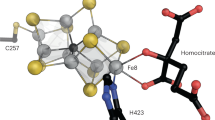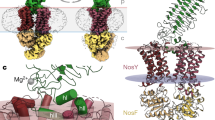Abstract
NITRATE is the major source of nitrogen for most green plants and fungi and may also be used by certain microorganisms as a terminal electron acceptor in place of oxygen under anaerobic conditions. The enzymes responsible for the first step in nitrate assimilation and for nitrate respiration are the nitrate reductases, both these processes involving the conversion of nitrate to nitrite. The nitrate reductases require molybdenum both for their formation and activity1,2. Chemical tests have indicated that during the enzymatic reduction of nitrate to nitrite, the oxidation state change undergone by the molybdenum present in the enzyme from Neurospora crassa involves Mo(V) and Mo(VI)3 and ESR spectroscopic studies have strongly suggested that the nitrate is directly bound to the Mo(V) centre of the enzyme from Micrococcus denitrificans before reduction4. Therefore we have investigated whether simple molybdenum(V) complexes are able to reduce nitrate to nitrite. This has been attempted previously and either no reduction of nitrate was detected3,5 or reduction occurred to yield nitric oxide as the major product6. Similarly, molybdenum-catalysed reductions of nitrate have produced at the most only traces of nitrite7–9.
This is a preview of subscription content, access via your institution
Access options
Subscribe to this journal
Receive 51 print issues and online access
$199.00 per year
only $3.90 per issue
Buy this article
- Purchase on Springer Link
- Instant access to full article PDF
Prices may be subject to local taxes which are calculated during checkout
Similar content being viewed by others
References
Spence, J. T., Coord. Chem. Rev., 4, 475–498 (1969).
Bray, R. C., and Swann, J. C., Structure and Bonding, 11, 107–144 (1971).
Nicholas, D. J. D., and Stevens, H. M., Nature, 176, 1066–1067 (1955).
Forget, P., and Dervartanian, D. V., Biochim. biophys. Acta, 256, 600–606 (1972).
Williams, R. J. P., and Mitchell, P. C. H., J. chem. Soc., 4570–4578 (1962).
Spence, J. T., and Guymon, E. P., J. Phys. Chem., 70, 1964–1969 (1966).
Haight, G. P., jun., Mohilner, P., and Katz, A., Acta chem. scand., 16, 221–228 (1962).
Spence, J. T., and Frank, J. H., J. Am. chem. Soc., 85, 116–119 (1963).
Spence, J. T., Archs Biochim. Biophys., 137, 287–290 (1970).
Mitchell, P. C. H., Q. Rev., 20, 103–118 (1966).
Addison, C. C., Logan, N., Wallwork, S. C., and Garner, C. D., Q. Rev., 25, 289–322 (1971).
Gray, H. B., and Hare, C. R., Inorg. Chem., 1, 363–368 (1962).
Pearson, R. G., Accounts Chem. Res., 4, 152–160 (1971).
Taube, H., J. chem. Educ., 45, 452–461 (1968).
Adapted from Vogel, A. I., A Text Book of Macro and Semimicro Qualitative Inorganic Analysis, fourth ed., 338 (Longmans, London, 1953).
Bird, G. R., and Baird, J. C., J. Chem. Phys., 28, 738–739 (1959).
Kay, A., and Mitchell, P. C. H., J. chem. Soc., A, 2421–2428 (1970).
Nason, A., Lee, K.-Y., Pan, S.-S., and Erickson, R. H., Proc. of Chemistry and Uses of Molybdenum Conference, Reading, England (edit. by Mitchell, P. C. H.), 233–239 (Climax Molybdenum Co., 1973).
Author information
Authors and Affiliations
Rights and permissions
About this article
Cite this article
GARNER, C., HYDE, M., MABBS, F. et al. Possible model reactions for the nitrate reductases. Nature 252, 579–580 (1974). https://doi.org/10.1038/252579a0
Received:
Issue Date:
DOI: https://doi.org/10.1038/252579a0
This article is cited by
Comments
By submitting a comment you agree to abide by our Terms and Community Guidelines. If you find something abusive or that does not comply with our terms or guidelines please flag it as inappropriate.



